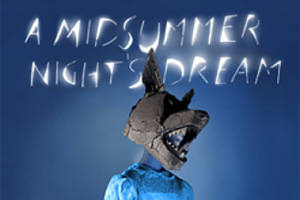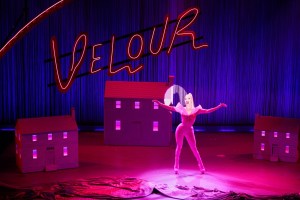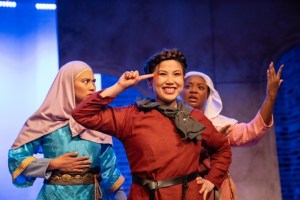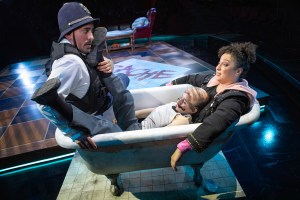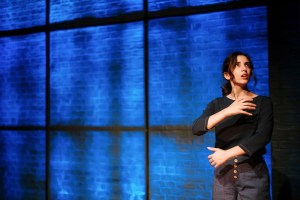A Midsummer Night’s Dream
Julie Taymor breaks in Theatre for a New Audience’s new home with this stunningly beautiful and wickedly funny new production.

(© Es Devlin)
You may feel like you’ve emerged from a dream when you leave the brand-new Polonsky Shakespeare Center (home of Theatre for a New Audience), which is taking its maiden voyage with Tony Award-winning director Julie Taymor’s visually sumptuous production of William Shakespeare’s A Midsummer Night's Dream. Ritualistic chanting, shadow puppetry, flying actors: It has all the elements that we’ve come to expect from the auteur-director of Broadway’s The Lion King and Spider-Man: Turn Off the Dark. It’s also quite funny, eliciting huge laughs from the smallest moments.
One of Shakespeare’s most beloved and produced comedies, A Midsummer Night’s Dream takes place on the eve of the wedding of Theseus, Duke of Athens (Roger Clark) and Hippolyta, the Amazon Queen (Okwui Okpokwasili). Hermia (Lilly Englert), Demetrius (Zach Appelman), Lysander (Jake Horowitz), and Helena (Mandi Masden) take to the Athenian woodlands to sort out their relationship issues. (Hermia loves Lysander, but is betrothed to Demetrius. Helena loves Demetrius. No one loves Helena.) This love quadrangle is made more complicated by the mischievous Puck (Kathryn Hunter), who bungles the orders of his master Oberon, King of Shadows (David Harewood): Suddenly all the boys love Helena. Meanwhile Oberon seeks to punish his wife, Queen Titania (Tina Benko), for her disobedience by using a magic potion to make her fall in love with an ass, who is really just part-time actor Nick Bottom (Max Casella, with perfect comic timing). Bottom and his troupe of Rude Mechanicals are staging a production of Pyramus and Thisbe for the Ducal wedding. Everyone has a good romp in the woods and the whole thing ends with a group wedding.
In this production, these events spring forth from Puck’s fevered dreams. At the top of the show a small bed occupies the center of an empty stage. As Puck lies down to nap, the wild and twisted branches of a tree rise from underneath the mattress, lifting Puck toward the rafters. The bed sheet expands to engulf the whole stage and remains present throughout much of the show. Sometimes it’s a screen for Sven Ortel’s psychedelic projections. Then it becomes the clouds surrounding Titania and Oberon’s feet. Taymor is endlessly inventive with everyday objects and the human body. In fact, the most awe-inspiring moments of this play are the ones that are the least technically complicated.
This is athletic, performer-centric theater. Anything that can be played by an actor is, making the wall played by Tom Snout (Jacob Ming-Trent) within the play-within-a-play, seem not so ridiculous after all. An ever-present chorus of 20 children portrays the fairies and spirits inhabiting the Athenian forest: They move tree branches, manipulate animal puppets, and play the rolling hills Demetrius and Helena run over in search of Hermia and Lysander.
The impish Hunter feels right at home within the child chorus. With simian flexibility and an elfin rasp, she offers up the most magical and memorable Puck I’ve seen. Hunter also endows every word with pristine clarity and a depth of meaning. This is the true hallmark of an accomplished Shakespearean actor. Unfortunately, not every member of the cast has this skill and at times the visual and aural elements drown out the language.
Still, the design is so arresting, one gets the sense that Taymor could easily tell this story with no words at all. Constance Hoffman’s breathtaking costumes run the gamut from big-budget cinematic grandeur (Titania is channeling Narnia‘s White Witch) to DIY whimsy: The Pyramus and Thisbe costumes are made almost entirely of paper, and Snug’s Lion (Brendan Averett) looks eerily similar to an earlier Taymor project, but with paintbrushes for a mane. Es Devlin’s set is light and nimble and makes good use of the trap doors under the stage. Lighting Designer Donald Holder and Sound Designer Matt Tierney keep the mood dark and supernatural, perfect for this enchanted forest of dreams.
Taymor’s longtime partner and collaborator Elliot Goldenthal has composed original music that enhances the dreamy state. It also has a Balkan feel to it, fitting for this Athenian setting. When the band strikes up a jaunty brass dance number at the wedding reception, you might have the sudden urge to join in.
It’s really rare and spectacular to see such a wide range of actors of all different ages and physical types on stage telling such a wildly imaginative story with such rigorous attention to detail. It’s a reminder that the need to share stories is a human instinct for both performer and audience. This is theater by everyone, for everyone.




